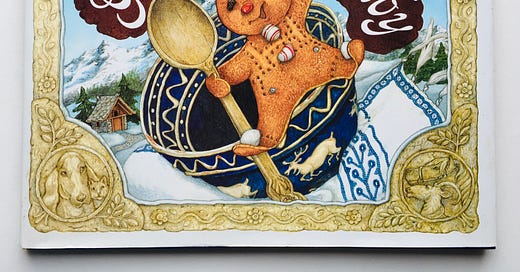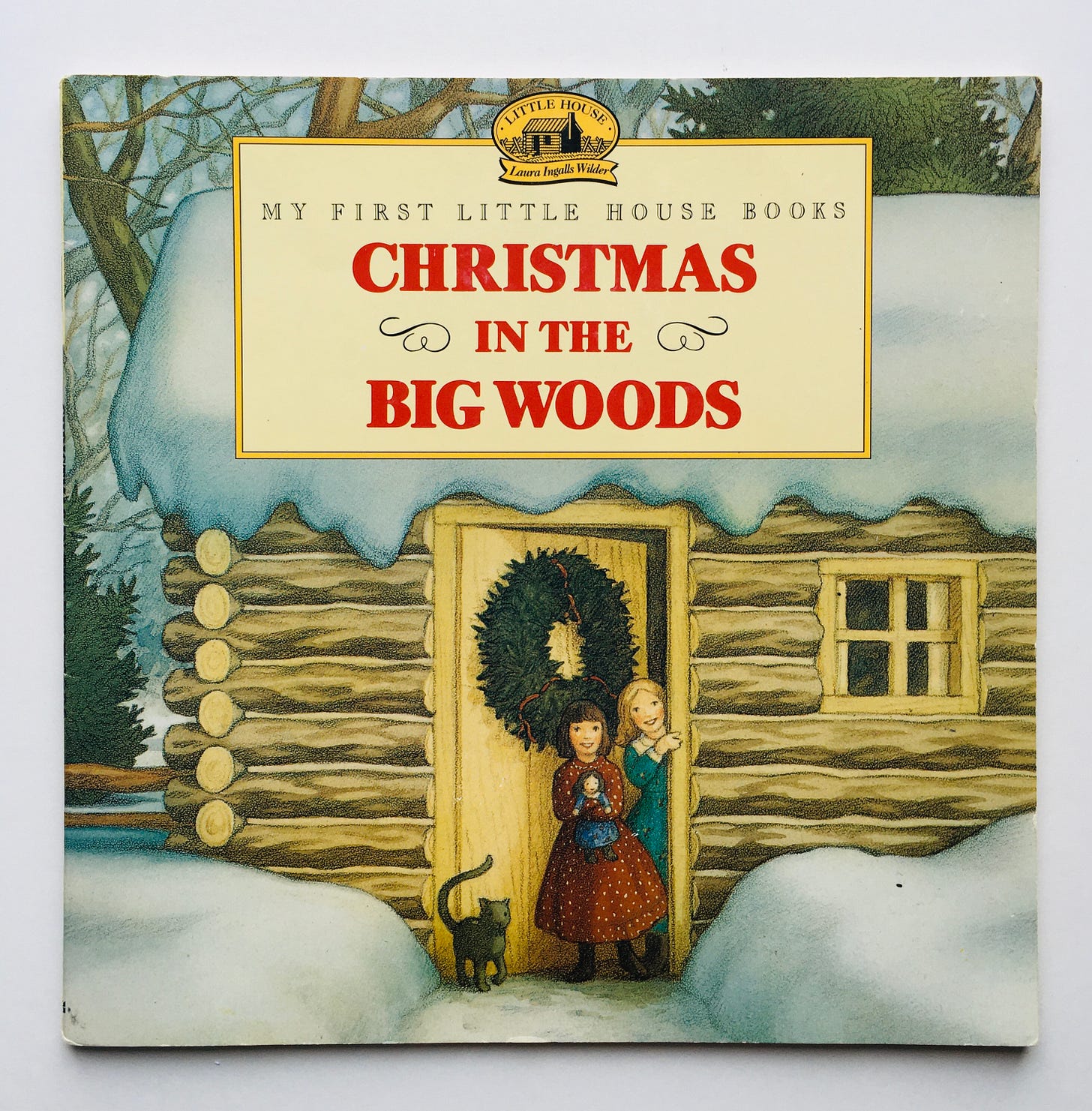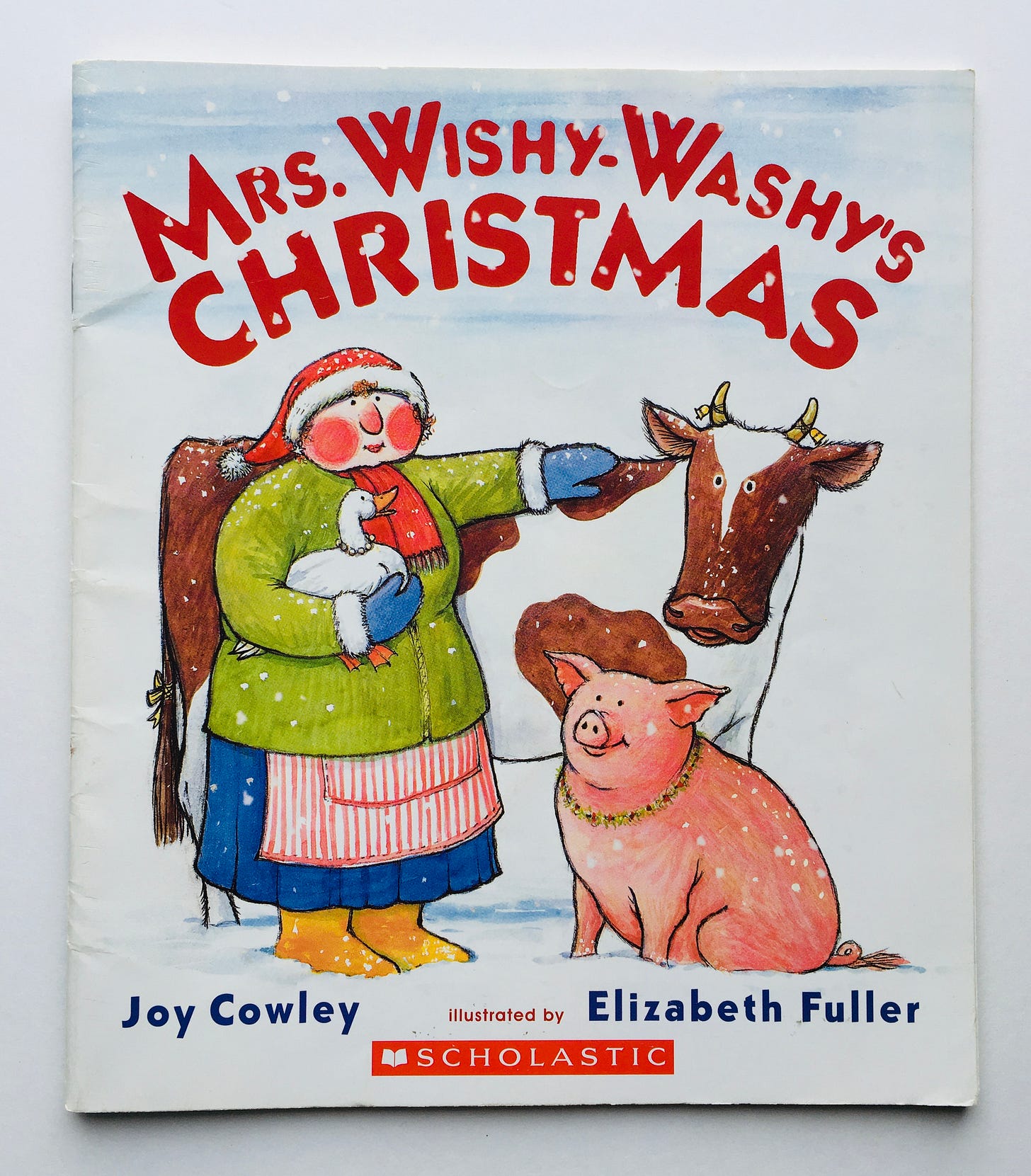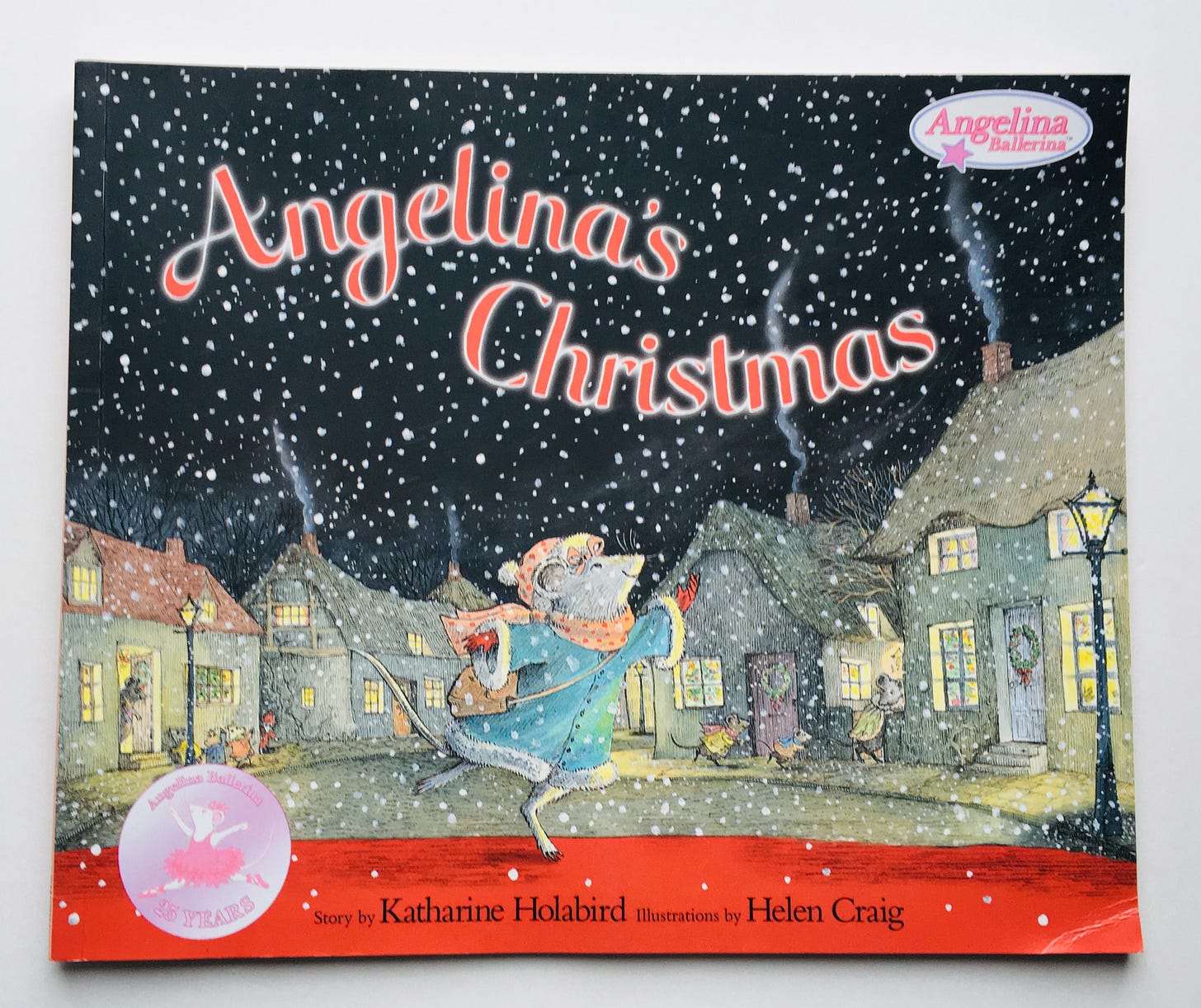Can we read? Special edition: 🎄 Christmas, Part 2
All is calm -- if you use a loose definition of "calm"🤪 -- all is bright
Hello!
ICYMI: you can find Part 1 of the special Christmas edition here. I reviewed five titles and included a long list of other highly recommended books, including specific lists for St. Nicholas titles, singing books, and titles for you. It’s my hope that you’ve already found a few gems to add to your own collection or gift to others. (I’d love to hear what you chose!)
Part 2 rounds out my Christmas offerings. Coming up in the next few weeks I’ll have three regular newsletters and finish up the year with a special edition for winter.
So let’s jump right in…
Gingerbread Baby by Jan Brett (1997)
No one, and I mean no one, beats Jan Brett when it comes to intricately detailed illustrations — she is the opposite of a visual minimalist, and while that’s wonderful in her regular titles (one of which I covered in issue No.5), she takes it to a whole other level of delight in those for Christmas. Gingerbread Baby is the first in a series of three titles about G Baby, his friends, and the wild escapades he gets up to. This title is so beloved by my four-year-old sometimes I dread pulling it from the Christmas box, knowing how often I will read it (and read it and read it) but I oblige her, of course, because that’s what I do, and because the story is so sweet (no pun intended — okay, maybe a little). I stand by what I wrote last week — I don’t believe in sharing any kind of variations on folk and fairy tales with children until they know the original, and Gingerbread Baby is no exception, but once your littles are familiar, please run right out and get a copy of this book. Last year I took a class on writing protection stories for children, and the instructor used this book as an example of one that ends with a sense of safety and comfort, and she was right — so right in fact, I haven’t found another title that does so as effectively. The tale is unchanged from the original in every aspect except one, and that’s the notable part: at the end, instead of being eaten by a wily fox, this gingerbread baby is welcomed to a tiny gingerbread house made especially for him by the boy who accidentally let him out of the oven too early, and it’s this gentle gesture of welcome, acceptance, and care that makes not only a lovely lesson for the season, but all year round. You too may come to dread reading and reading and reading Gingerbread Baby (we should all be so lucky to fulfill this need of a child’s), but I promise: it’s worth it.
Christmas in the Big Woods by Laura Ingalls Wilder, illustrated by Renee Graef (1995)
Let me say upfront that I never read any of the Little House on the Prairie books as a kid (I really have no idea how this happened given that I was as voracious a reader as a child as I am as an adult), nor have I ever amended that, either on my own or with my children. I know they’re beloved by many, and I also know that they have not stood the test of time in terms of cultural sensitivity and outright racism, so I can’t speak to them as chapter books. I can, however, speak from experience of having read all of the My First Little House picture books series, which hews closely to the narrative of the longer books in a necessary stripped-down way with, obviously, many thousand fewer words and condensing of the stories. What these books have is all the homey interest of the original texts — plus soft, lovely illustrations from Graef — without the seriously problematic larger themes. In the Christmas version, the reader sees Laura, always “with her Ma, her Pa, her big sister Mary, her little sister Carrie, and their good old bulldog Jack” (every title begins this way), as they prepare for and enjoy the holiday — welcoming visiting family, playing in the snow with their cousins, waking up on Christmas morning to stockings filled with mittens and peppermint candy. Their Christmas is as simple as one would expect from anyone living in a log cabin in Wisconsin in the late 19th century, but there is no lack here: Laura’s world, as it ever is, is filled with the warm, quaint excitement of yesteryear and lots and lots of familial love. That’s the quality of the Little House books that has, thankfully, stayed.
Mrs. Wishy Washy’s Christmas by Joy Cowley, illustrated by Elisabeth Fuller (2005)
When both my children were toddlers they insisted on reading this on repeat (they come by their obsessive reading tendencies honestly 🤷🏻♀️) and it’s not surprising: Mrs. Wishy-Washy brings that out in kids, in my experience. Cowley has created a truly lovable, quiet character in Mrs. Wishy-Washy, and in every title — this one included — her barnyard of animals always serve as the perfect foil. Here, when Mrs. Wishy Washy tells them to take a bath, they’re appalled at the idea of a cold one out in the yard, so when she leaves for town, they take matters into their own hands and head inside the house — right into the pink tub, complete with “pink towels, a little pink rug and water as warm as a friendly hug.” You can imagine the farmer’s surprise when she arrives home. What I like most about each of Cowley’s Wishy Washy titles is two-fold: Fuller’s warm, friendly illustrations and Mrs. Wishy Washy’s clear love for her animals (it’s a perfect match). She’s a forgiving lady (and certainly more lighthearted than I would be) — “Fiddle-dee-dee! I’m not as mad as I ought to be. Cow, pig, duck, it’s the time of year for peace and happiness and good cheer.” Absolutely.
Angelina’s Christmas by Katharine Holabird, illustrated by Helen Craig (1985)
I stand by what I said in my special Halloween edition of this newsletter about character books — I also maintain that Angelina, while now commercialized and not as good as she used to be (through no fault of her own) was a lovable and valuable character before TV got its claws into her. That’s what I value the most about this particular title: here, walking home from preparing for the Christmas show, Angelina peeks into a neighbor’s window to see Mr. Bell — who used to be the village postman but is now too old to work — and immediately decides to make him up a basket of cookies, mince pies, and fruit as a Christmas surprise. In her preparations for this kind deed, she is, in typical Angelina fashion, momentarily harsh (I have called her a bit of a dick in the past, and it’s true) to her younger cousin, Henry, so the next day when she asks Henry to join her in delivering the basket, he declines, but follows at a distance as Angelina and her father cut down a Christmas tree for Mr. Bell. When they arrive at the gentleman’s house, Mr. Bell notices Henry’s downcast mood and changes everything for the little mouse when Bell transforms (secretly) into Santa Claus, sharing stories of his past and making Henry feel seen in a way he is often not (and almost never by Angelina). What I like about this title is two-fold: first, the story of taking care of an lonely elder at Christmastime (or anytime) is presented in a light-handed and yet wonderfully warm and instructive way (this is an exceedingly rare thing in picture books); and second, Angelina is the perfect of example of how human we’re all capable of being: she’s not perfect, she has moments of unkindness like we all do, and yet she’s still a good mouse with a good heart. I think we all need the reminder that what we do matters, but so does who we are.
Christmas Farm by Mary Lyn Ray, illustrated by Barry Root (2008)
“Wilma had grown petunias and sunflowers for years. She was ready to graduate to something else. But she couldn’t decide what.” So begins the slow and steady story of an older woman who plants sixty-two dozen balsam trees. Over the course of five years, with the help of her small neighbor, Parker, (who himself grows from five years old), she tends her crop through all the seasons, taking a loss from all kinds of plant-eaters, enduring the long wait. Finally — after so much love and care, demonstrated beautifully through Root’s smudgy, inviting illustrations — Wilma and Parker open up their very own Christmas Farm, delighting in the joy their trees bring to all kinds of customers and in the part that comes next: ordering eighty-three dozen new seedlings, and waiting again for spring. The relationship between Wilma and Parker — especially as he grows older, at the age when hanging out with your older neighbor might not be so appealing anymore — is especially tender and runs like a root beneath the narrative of nurturing trees. This is a quiet, even peaceful story (best for those past their very young years) with lovely messages about work, and patience, and faith: what growing things need, be it friendship or trees.
Titles that tell the story of Christmas from the Christian perspective:
Santa’s Favorite Story by Hisako Aoki
The Donkey’s Dream by Barbara Helen Berger (this is one of our favorite Christmas titles, full of Berger’s strange dreaminess that I have written about before in issues No. 13 and No. 18)
Babushka by Dawn Casey (Babushka tales are a Russian version of the Italian Befana story, though Babushka is not overtly a witch whereas Befana is)
Room for a Little One: A Christmas Tale by Martin Waddell
Silent Night, illustrated by Susan Jeffers (Jeffers’ illustrations are breathtaking; I especially like this one as it’s one of few titles, Christmas or otherwise, that shows a baby nursing)
Who is Coming to Our House? by Joseph Slate
Especially for babies and toddlers:
Carl’s Christmas by Alexandra Day
On Christmas Day in the Morning by John Langstaff (also mentioned last week, under “Singing books”)
Frosty the Snowman by Jack Rollins and Steve Nelson, illustrated by Rebecca Thornburgh (also mentioned last week, under “Singing books”)
Snowflake Kisses and Gingerbread Smiles by Toni Trent Parker
Little Blue Truck’s Christmas by Alice Schertle
Who is Coming to Our House? by Joseph Slate (this is a religious title, as noted above)
Bear Stays Up for Christmas by Karma Wilson
Merry Christmas, Big Hungry Bear! by Audrey and Don Wood
Especially for big kids (8+, though these could absolutely be read-alouds for younger ones):
(There may also be some overlap here with the “Titles for you” suggestions I made in Part 1, depending on the age and ability of the reader)
Have Fun, Anna Hibiscus! by Atinuke (highly recommend as an audiobook — Mutiyat Ade-Salu does an amazing job narrating all of the Anna Hibiscus books)
Tumtum & Nutmeg’s Christmas Adventure by Emily Bearn
The Angel Tree by Daphne Benedis-Grab
The Family Under the Bridge by Natalie Savage Carlson
The Story of Holly & Ivy by Rumer Godden
The Gift of the Magi by O. Henry
Nutcracker by E.T.A. Hoffman
The True Gift by Patricia MacLachlan
Otto and the Secret Light of Christmas by Nora Surojegin
The Best Christmas Pageant Ever by Barbara Robinson
A Child’s Christmas in Wales by Dylan Thomas
A Little House Christmas by Laura Ingalls Wilder
Solstice:
We celebrate winter solstice every year (December 21, in 2020) in a simple yet wondrous way: we have dinner in total darkness, all the lights in the house off, with only candles lighting the table. Though we eat by candlelight almost daily, at breakfast and dinner in the dark months — which is like eight months of the year here — there is something about turning off every single light that’s truly breathtaking. I’m not sure my kids really understand what winter solstice is yet, but they understand celebrating light in darkness — there’s something very human in that.
Sun Bread by Elisa Kleven (includes a recipe for making sun bread; super fun)
The Return of the Light: Twelve Tales from Around the World for the Winter Solstice by Carolyn McVickar Edwards
The Shortest Day: Celebrating the Winter Solstice by Wendy Pfeffer
Everything else (not already covered in this issue or last):
Paddington and the Christmas Surprise by Michael Bond
Gingerbread Mouse by Katy Bratun
Christmas Trolls by Jan Brett
Gingerbread Friends by Jan Brett (this the second in the Gingerbread Baby series; the first is reviewed above, the third is Gingerbread Christmas)
Home for Christmas by Jan Brett
Who’s That Knocking on Christmas Eve? by Jan Brett
Father Christmas by Raymond Briggs
Arthur’s Christmas by Marc Brown
Santa Mouse by Michael Brown
Santa’s Secret Helper by Andrew Clements (Mrs. Claus FTW!)
Babar and Father Christmas by Jean de Brunhoff
Guess Who’s Coming to Santa’s for Dinner? by Tomie dePaola
Stick Man by Julia Donaldson
A Merry Little Christmas: Celebrate From A to Z by Mary Engelbreit
Christmas Kitten by Vivian French
The Story of the Nutcracker Ballet by Deborah Hautzig
Alfie’s Christmas by Shirley Hughes
The Littlest Christmas Tree: A Tale of Growing and Becoming by Janie Jasin
The Nutcracker by Susan Jeffers
The Dog Who Found Christmas by Linda Jennings
The Biggest Christmas Tree Ever by Steven Kroll
Sleeping Moon by David Lewis Atwell
Christmas in Noisy Village by Astrid Lindgren (if all you know of Lindgren is Pippi Longstocking, you are seriously missing out)
Zelda and Ivy One Christmas by Laura McGee Kvasnosky
Henry Bear’s Christmas by David McPhail
A Wish to be a Christmas Tree by Colleen Monroe
The Night Before Christmas by Clement C. Moore, illustrated by Jan Brett
The Night Before Christmas by Clement C. Moore, illustrated by Jerry Smath
It’s Christmas by Jack Prelutsky (poetry)
Tree of Cranes by Allen Say
Christmas with the Mousekins by Maggie Smith (if you’re looking for fun Christmas projects, there are plenty of them interspersed within the narrative here)
Eloise at Christmastime by Kay Thompson
The Spirit of Christmas by Nancy Tillman
Can You See What I See? The Night Before Christmas: Picture Puzzles to Search and Solve by Walter Wick (a seek-and-find)
I Spy Christmas: A Book of Picture Riddles by Walter Wick and Jean Marzollo (a seek-and-find)
Phew! That’s it. That’s all I’ve got, folks. I hope this issue (and the last) have been helpful. Please reply if there is any other way I can be useful.
I thought of taking some time off from this newsletter at the end of the year, but no. This is one of the only things in my life from which I get 100%, unadulterated pleasure, so I’m just going to keep writing and sharing. Thank you for continuing to read!
And Merry Christmas to you and your family. I know this year hasn’t been one to celebrate, necessarily, but we’ve made it this far, and that’s not nothing (actually, that’s everything). I wish you good health, good cheer — and peace in these coming weeks and throughout the new year ❤️ 💚









This list is incredible, Sarah! Thank you! Thank you! Thank you!